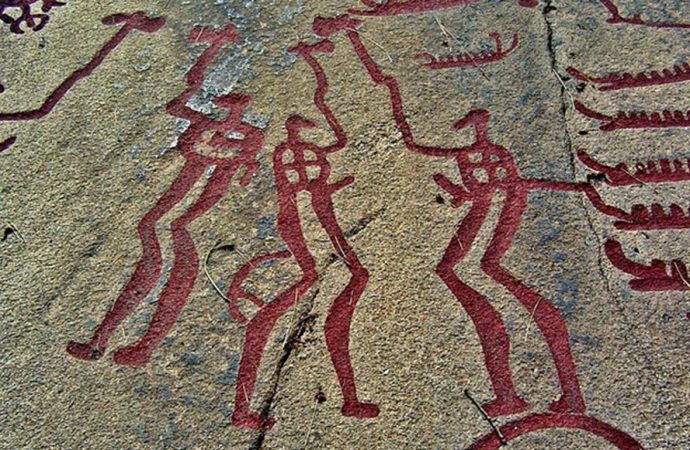The people living in the bronze age of Sweden were invaded by a force coming from a distant land, according to the artifacts.
Researchers analyzing bronze daggers, swords, and axes found in bogs and graves at various places in Sweden over the years have made a surprising find. Some of the artifacts date as far back 3,600 years ago, and they say the objects were made with copper from southern Europe, Turkey, and Cyprus.
The researchers determined the place of the origin of the copper and tin in the tools by analyzing isotopes and comparing it to metals from places in Europe where there were mines in prehistoric times.
Copper, which is a pure element, when mixed with tin or other metals becomes an alloy called bronze. The mixing of the two metals makes bronze stronger than copper alone. This development revolutionized tool- and weapon-making.
Some peoples around the world fashioned copper into tools and weapons before the Bronze Age, but those implements were not as strong.
The production of bronze allowed for more intensive farming, a population increase, and, unfortunately, more widespread and devastating warfare. The Bronze Age lasted from the 3rd to 1st millennium BC in Eurasia.
Researchers also believe that rock carvings near where a few of the copper tools were found, in Bohuslän, Sweden, depict ships that were trading from the Mediterranean region.
The distance from Cyprus to Sweden is about 3,000 kilometers or 1,865 miles as the crow flies. The actual route would have taken traders across the Mediterranean Sea and up the Atlantic coast of Europe or the reverse route from Sweden. Or, traders could have carried it overland, through thick forests and sparsely populated areas.
No matter how the copper from which the knives and axes got to Sweden, the journey was sure to have been an adventure for the traders and crew.
Dr. Johan Ling of Sweden’s Gothenburg University and his team did isotope analysis on 70-some bronze daggers, swords and axes and proved that some came from Cypriot copper mines. Cyprus is at the far eastern end of the Mediterranean, off the coasts of Syria and Turkey.
The copper may have been traded for amber—another key element of Bronze Age trade.
“Some of the axes and not least the swords were made for combat,” Dr. Ling told Ancient Origins via e-mail. “There exists some concrete evidence of wounded skeletons. Some of the artefacts are from graves with other items and features. Most of the artefacts derive from hoards from a wet environment or from graves.”
Most of the artifacts that dated to 2000 to 1500 BC were made with copper ore mined in North Tyrol and apparently traded north to Sweden. Many of the artifacts during the period of 1500 to 1100 BC were from copper mined in the Italian Alps. During the period of 1100 to700 BC, the ores came from southern Iberia and North Tyrol. Some tin came from Cornwall, England, and from southern Germany, Dr. Ling said in the email. “Well, it should be stressed that the Cypriote copper was rather limited,” he wrote.
There is no evidence for copper indigenous to Bronze Age Scandinavia, he added.
Professor Kristian Kristiansen, Dr. Ling’s colleague at the university’s department of archaeology, told In.Cyprus.com that “Bronze was as valuable a raw material as oil is today.”
Bronze and amber were what he called the twin engines of the economy of the time. Marriage alliances may even have been entered into by powerful European families to secure the amber trade, In.Cyprus.com says.
We asked Dr. Ling if he agrees with Professor Kristiansen about bronze and amber being the main drivers of the Bronze Age economy.
“Partly, but I think this is a misunderstanding,” he replied. “Kristian and me argue that Maritime trade of metals, together with amber and slaves were the main drivers for the Bronze Age economy.”
The people of Sweden at the time based their economy on agriculture and fishing, he said.
Historians divide early human prehistory and history into three main ages: first the Stone Age (Paleolithic), then the Bronze Age and finally the Iron Age.
Copper could be melted and cast in molds to produce many weapons or tools from one mold, says the site Classroom.synonyms.com. The strong metal didn’t break, crack or chip and could be bent and shaped into efficient configurations. It could also be incised with decorations.
Weapons and tools made from the metal included knives, swords, axes, daggers, spearheads, helmets, cauldrons, razors, buckets, horns and plows and other highly useful artifacts.
Classroom.com says the only type of army that had an advantage over an army with bronze weapons were forces on horseback armed with bronze. The metal was so much stronger and sharper than copper alone or weapons made of wood or stone, that people armed with it were dominant.
Source: Ancient Origins

































Leave a Comment
You must be logged in to post a comment.